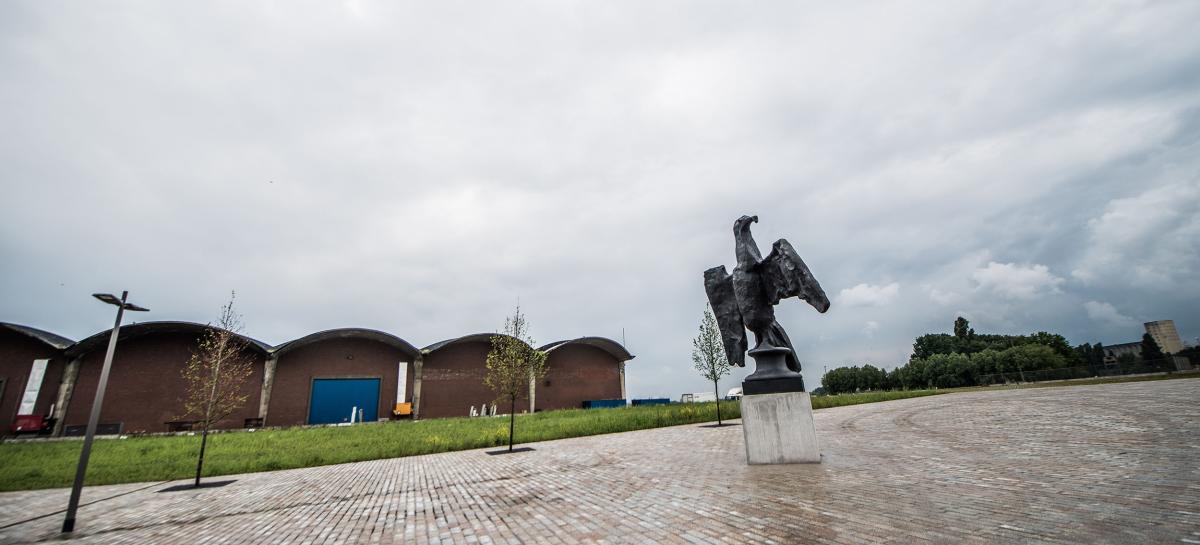Pliny’s Sorrow is an impressive bronze sculpture by the Flemish artist Johan Creten, who lives in Paris. This sculpture is on permanent public display at the Rijnkaai.This complex sculpture symbolises the courage of the individual, preparing to embark on a long and arduous journey, highlighting his vulnerability. It has been installed in the exact location where migrants used to board the Red Star Line ships to America in hopes of a better life.
The City of Antwerp recently purchased Pliny’s Sorrow. In 2014 Johan Creten created this sculpture for a retrospective of his work in Middelheim Museum in Antwerp. The Storm featured a combination of new and existing work. This is the first statue of this dimension by Creten to be displayed in public space in Belgium.
Pliny’s Sorrow
Pliny’s Sorrow has multiple layers of meaning. The public often associates the eagle spreading its wings with a symbol of power from European history, from Julius Caesar over Napoleon to Germany. The eagle also embodies the American ideal of freedom.
At first glance, the work exudes raw power, even dominance. But once you look closer, you realise that this is not actually an eagle. The long neck and beak indicate that the work was inspired by a water bird, like the cormorant. This idea is underscored by the bollard as a pedestal.
The rough skin, the impressionistic finish of the elongated body and the openwork on the back of the sculpture lend the imposing, outspread wings a sense of fragility. This is also a vulnerable creature.
The significance and the location
The public space brings the multiple layers of meaning of the work to the fore. In the relatively enclosed gardens of Middelheim Museum, the first layer was more strongly emphasised. The proportions of the public space along Rijnkaai, with its industrial heritage, monumental façades and the enormous volume of the Scheldt’s water, emphasise the work’s inherent vulnerability more.
The migrants of the Red Star Line
In this location, the work even takes on an additional layer of meaning: here the bird also represents the courage (and despair) of the individual, as he prepares to undertake a long and arduous journey.
One hundred years ago, millions of European migrants took their last steps on the old continent here, en route to an uncertain future in America. The large bollards down the road mark the place where the Red Star Line’s flagship, the “Belgenland II” used to moor.
The work’s title also refers to a sense of loss or desire, similar to the theme of migration, the main theme of the Red Star Line Museum’s exhibits. However, the journey can also be proverbial, symbolising our own individual development, embodying mankind and the combination of power and fragility. The duality between wanting to leave the safety of the nest while still requiring protection often is especially apparent in young people.
The artist and his work
Johan Creten (°1963, Sint-Truiden) was born in Belgium but has been living and working in Paris for several years. During the past thirty years, the artist created a sizeable body of work, comprising bronze and ceramic sculptures.
He often chooses historically relevant sites to present these works, including a quarantine area in the Mediterranean or an underground drinking water reservoir from Byzantine times (in Istanbul).
He was the first living Belgian sculptor to exhibit his work in a solo exhibition in the Louvre’s Renaissance galleries (Paris). His sculptures will also be on display in The Hague, Monaco, Venice and New York later this year.
In 2014, he combined existing and new work for the summer exhibition The Storm in Middelheim Museum, including 25 bronze sculptures and several ceramic works. It was the first time that such a large body of work was exhibited in Creten’s native Belgium. Pliny’s Sorrow is the artist’s first monumental work to be displayed in public space.
Sculpture in the city
After the exhibition in Middelheim Museum closed, the City of Antwerp purchased Pliny’s Sorrow for the museum’s permanent collection. The Sculpture in the City Commission recommended installing this work in public space to better bring out the multiple layers of meaning.
Johan Creten’s impressive sculpture Pliny’s Sorrow now welcomes visitors in the new square, opposite Rijnkaai, with a view of the River Scheldt, right next to the place where two million migrants embarked on their journey to America.
Technical data
- Pliny’s Sorrow, 2011-2013
- Patinated bronze, lost wax technique
- Signed, dated, artist’s mark, foundry’s mark
- 450 x 450 x 190 cm
- 1,820 kilos
- Edition of 1 plus 1 Artist Proof and 1 master model in resin
- After a clay model, in the collection of the musée de la Chasse et de la Nature in Paris


